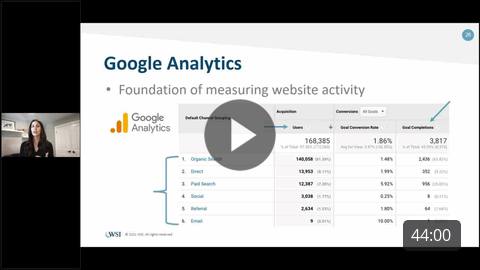WSI Digital Marketing Consultant Denise Bowen is passionate about helping businesses reach their growth goals. Drawing on her extensive knowledge of digital marketing, including web user experience (UX), conversion rate optimization, paid ads, and search engine optimization, Denise hosted a recent webinar on measuring the success of your digital marketing. Watch the webinar recording here and read our recap below.
Benefits of Measuring Online Lead Gen Activities
Knowing how well your current marketing efforts are performing and delivering the best results helps you make smarter decisions.
You can calculate the ROI by quantifying the dollars made from each effort, and you will see what to continue and what needs to be stopped or changed.
This, in turn, guides your decisions on next year’s marketing budget allocation.
It is not just marketing that can be changed - these metrics also offer insights about changes necessary in your operations and systems.
1. Understanding the Metrics Better
There is so much out there; focus on tracking what is important to you. Below are some key metrics many businesses monitor.
User info is useful when marketing efforts are in place to bring people to your website:
- Website traffic = total traffic, new users, and traffic source (organic, paid, social)
- Demographics = location, age, and gender of those who search for your site directly from the URL bar
- Technology = device type, device info, and browser
- Activity = page views, duration, and conversion rate (the number of users who took the desired action over the total number of site visitors)
Website leads are created when visitors complete a goal and convert on your website. These conversions can include things like phone calls (tracked through a phone tracking service on your website page), form submissions, newsletter subscription sign-ups, or online chats (for example, how many chats were started compared to how many convert into customers?).
Website events are less direct actions that you still want users to carry out. These include things like web page clicks, video plays, site searches, or PDF downloads.
Ecommerce websites need sales-specific measurements such as purchases, average order value, cart abandonment, conversion rate, or acquisition cost. And if you want to dig deeper into how to measure Ecommerce success, check out our post here.
Paid ads spend is expected to reach $389 billion globally in 2021. With so much skin in the game, you may also want to consider measuring things like:
- Impressions (how many times your ad is viewed)
- Click-through rate (CTR) (the number of clicks on your ad versus the total number of users who saw your ad)
- Conversions (the number of clicks that led to a goal completion on your website)
- Conversion rate (the percentage of users who converted on your site over the total number of users who clicked)
- Cost per click (CPC) and leads
- Return on ad spend (ROAS)
There are free analysis tools online that you can check out. Or you can ask your local WSI digital marketing consultant to guide you on measuring how much you are getting out of what you are putting in.
2. Lead Tracking Attribution
This marketing term refers to tracking – or attributing – each lead to a source, campaign, or channel, such as SEO, paid ads, social media, email marketing, blogging, referrals, and so on.
Start by installing Google Analytics on your website – it is the best way to track traffic and traffic sources on your website:
- Set up dynamic call tracking to determine the source of visitors who called using the number on your website.
- Use contact forms to monitor which emails originated from your website users. Create unique thank you pages to help track the source of the form filling.
- Ecommerce sites can be set up to track purchases directly on Google Analytics or through a plug-in.
As comprehensive as Google Analytics is, it does have limitations. A robust CRM (customer relationship management) tool provides more accurate and in-depth data about each customer’s path. Look at platforms like HubSpot or Zoho to get started.
To attribute paid ad campaigns, use the analytics on each platform (Google Ads, Facebook, Instagram, etc) to get the data you want.
3. Testing
For all this data to help you accomplish your goals, you need to test which changes will help improve results. It’s a good idea to start by testing what isn’t working.
AB / Split Testing compares two versions of something to find out which of the two performs better. You can look at colors, placements, wording, images, actions (redirects). But be careful about not testing too many things at once because then your results will be too vague.
Heat mapping tracks mouse movement to show user behavior on a website page.
Combining these two gives you even greater insights that will move you towards your goal.
And it's important that you don't rush testing. Allow time to gather a large enough sample size of users or data to make any conclusions. Furthermore, testing is a reiterative process. For optimal results, test, analyze, then repeat!
4. Dashboards and Benchmarks
Tracking is not a one-time thing. You need to be able to compare figures to previous periods (monthly, annually, seasonally). Consistent reporting reveals trends. Display data in dashboards for a holistic view and to help you spot trends quickly.
A comprehensive dashboard provides a central overview of all these metrics. It can be divided into sections and customized to display what’s important to you. In addition, each element can be expanded if you need to dive deeper.
5. Competitor Insights
How do your metrics stack up against your competitors? You can compare things like website traffic, organic research, paid ads, and social media through competitive research.
Review your competitors’ marketing efforts once to twice a year to stay abreast of changes they’ve made. Look for gaps that you need to plug and invest more into the unique things that help you stand out from the crowd.
Would you like to learn how your website stacks up against your top competitors and identify some initial marketing opportunities for your business? Then visit our webinar landing page for a free competitive analysis! And for more information on measuring the success of your digital marketing, get in touch with your friendly WSI Internet Consultant without delay! Or catch up on the full recording here:







